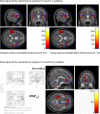Prior context influences motor brain areas in an auditory oddball task and prefrontal cortex multitasking modelling
- PMID: 33745089
- PMCID: PMC7982371
- DOI: 10.1186/s40708-021-00124-6
Prior context influences motor brain areas in an auditory oddball task and prefrontal cortex multitasking modelling
Abstract
In this study, the relationship of orienting of attention, motor control and the Stimulus- (SDN) and Goal-Driven Networks (GDN) was explored through an innovative method for fMRI analysis considering all voxels in four experimental conditions: standard target (Goal; G), novel (N), neutral (Z) and noisy target (NG). First, average reaction times (RTs) for each condition were calculated. In the second-level analysis, 'distracted' participants, as indicated by slower RTs, evoked brain activations and differences in both hemispheres' neural networks for selective attention, while the participants, as a whole, demonstrated mainly left cortical and subcortical activations. A context analysis was run in the behaviourally distracted participant group contrasting the trials immediately prior to the G trials, namely one of the Z, N or NG conditions, i.e. Z.G, N.G, NG.G. Results showed different prefrontal activations dependent on prior context in the auditory modality, recruiting between 1 to 10 prefrontal areas. The higher the motor response and influence of the previous novel stimulus, the more prefrontal areas were engaged, which extends the findings of hierarchical studies of prefrontal control of attention and better explains how auditory processing interferes with movement. Also, the current study addressed how subcortical loops and models of previous motor response affected the signal processing of the novel stimulus, when this was presented laterally or simultaneously with the target. This multitasking model could enhance our understanding on how an auditory stimulus is affecting motor responses in a way that is self-induced, by taking into account prior context, as demonstrated in the standard condition and as supported by Pulvinar activations complementing visual findings. Moreover, current BCI works address some multimodal stimulus-driven systems.
Keywords: Attention; Cognitive modelling; Cue–target onset asynchrony (CTOA); Electroencephalography (EEG); Event-related potential (ERP); Executive function; Functional magnetic resonance imaging (fMRI); Motor networks; Multitask applications; Orienting of attention; Prefrontal cortex (PFC); Running average reaction times.
Conflict of interest statement
The authors declare that the research was conducted in the absence of any commercial or financial relationships that could be construed as a potential conflict of interest.
Figures






Similar articles
-
Neural mechanisms of training an auditory event-related potential task in a brain-computer interface context.Hum Brain Mapp. 2019 Jun 1;40(8):2399-2412. doi: 10.1002/hbm.24531. Epub 2019 Jan 28. Hum Brain Mapp. 2019. PMID: 30693612 Free PMC article.
-
Self vs. other: neural correlates underlying agent identification based on unimodal auditory information as revealed by electrotomography (sLORETA).Neuroscience. 2014 Feb 14;259:25-34. doi: 10.1016/j.neuroscience.2013.11.042. Epub 2013 Dec 1. Neuroscience. 2014. PMID: 24295635
-
Orienting and maintenance of spatial attention in audition and vision: multimodal and modality-specific brain activations.Brain Struct Funct. 2007 Sep;212(2):181-94. doi: 10.1007/s00429-007-0152-2. Epub 2007 Jul 18. Brain Struct Funct. 2007. PMID: 17717689
-
Stimulus-dependent activations and attention-related modulations in the auditory cortex: a meta-analysis of fMRI studies.Hear Res. 2014 Jan;307:29-41. doi: 10.1016/j.heares.2013.08.001. Epub 2013 Aug 11. Hear Res. 2014. PMID: 23938208 Review.
-
Integrated technology for evaluation of brain function and neural plasticity.Phys Med Rehabil Clin N Am. 2004 Feb;15(1):263-306. doi: 10.1016/s1047-9651(03)00124-4. Phys Med Rehabil Clin N Am. 2004. PMID: 15029909 Review.
Cited by
-
Different Markov chains modulate visual stimuli processing in a Go-Go experiment in 2D, 3D, and augmented reality.Front Hum Neurosci. 2022 Nov 21;16:955534. doi: 10.3389/fnhum.2022.955534. eCollection 2022. Front Hum Neurosci. 2022. PMID: 36569471 Free PMC article.
-
A comparative study of EEG microstate dynamics during happy and sad music videos.Front Hum Neurosci. 2025 Feb 6;18:1469468. doi: 10.3389/fnhum.2024.1469468. eCollection 2024. Front Hum Neurosci. 2025. PMID: 39980907 Free PMC article.
-
MCGNet+: an improved motor imagery classification based on cosine similarity.Brain Inform. 2022 Feb 1;9(1):3. doi: 10.1186/s40708-021-00151-3. Brain Inform. 2022. PMID: 35103873 Free PMC article.
-
Facebook/Meta usage in higher education: A deep learning-based dual-stage SEM-ANN analysis.Educ Inf Technol (Dordr). 2022;27(7):9821-9855. doi: 10.1007/s10639-022-11012-9. Epub 2022 Apr 5. Educ Inf Technol (Dordr). 2022. PMID: 35399779 Free PMC article.
-
The Effect of Context and Individual Differences in Human-Generated Randomness.Cogn Sci. 2021 Dec;45(12):e13072. doi: 10.1111/cogs.13072. Cogn Sci. 2021. PMID: 34913501 Free PMC article.
References
-
- Wu L, Wang Y, Gao J, Wang M, Zha ZJ, Tao D. Deep co-attention based comparator for relative representation learning in person re-identification. IEEE Trans Neural Netw Learn Syst. 2020. - PubMed
Grants and funding
LinkOut - more resources
Full Text Sources
Other Literature Sources
Miscellaneous

